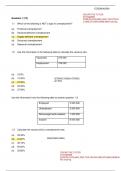ECS2604/2024
OSCAR THE TUTOR
0737560989
Question 1 [12]
FORFAC,ECS,MAC,DSC,TAX,FIN,IN
V,QMI,STA,BNU,MNB,MNG tutoring
1.1 Which of the following is NOT a type of unemployment?
(a) Frictional unemployment
(b) Demand-deficient unemployment
(c) Supply-deficient unemployment
(d) Structural unemployment
(e) Seasonal unemployment
1.2 Use the information in the following table to calculate the vacancy rate:
Vacancies 275 000
Employment 725 000
(a) 3.33%
(b) 13.33% =275000/(725000+275000)
=27.50%
(c) 27.50%
(d) 33.33%
(e) 37.93%
Use the information from the following table to answer question 1.3:
Employed 3 500 000
Unemployed 2 500 000
Discouraged work-seekers 1 000 000
Inactive 6 000 000
1.3 Calculate the narrow (strict) unemployment rate.
(a) 33.33%
(b) 41.67% 2500/(2500+3500)
(c) 46.15%
(d) 50.00%
(e) 53.85%
OSCAR THE TUTOR
0737560989
FORFAC,ECS,MAC,DSC,TAX,FIN,INV,QMI,STA,BNU,MNB,M
NG tutoring
, ECS2604/2024
1.4 In a hypothetical firm, it is given that male wage = R30, female wage = R25, and discrimination
coefficient = R5, with the employer discriminating against female workers. The employer will:
(a) only hire male workers.
(b) only hire female workers.
(c) not hire any workers.
(d) be indifferent to choosing between hiring male or female workers.
(e) reduce the wages of both groups.
1.5 Kim and Bongani are lecturers at the Department of Economics at the University of Miracle.
They have the same years of experience, educational qualifications and productivity, and are
lecturing the same courses. However, Kim is paid R1000 more than Bongani per month, only
because her home language is English. This is an example of
(a) human capital discrimination.
(b) employment discrimination.
(c) wage discrimination.
(d) occupational discrimination.
(e) None of the above is correct
1.6 Which of the following is NOT an expense of acquiring human capital?
(a) Purchase of textbooks
(b) Purchase of stationery and computer
(c) Anxiety caused by writing tests and exams
(d) Study fees paid
(e) Cost of food while eating at a restaurant
Question 2 [8]
Answer if the question is TRUE/FALSE and state the reason why the statement is
TRUE/FALSE.
2.1 The labour force participation rate of women in South Africa has changed since 1990. (4) TRUE
2.2 South Africa’s Social welfare net discourages women from seeking work. (4) FALSE




